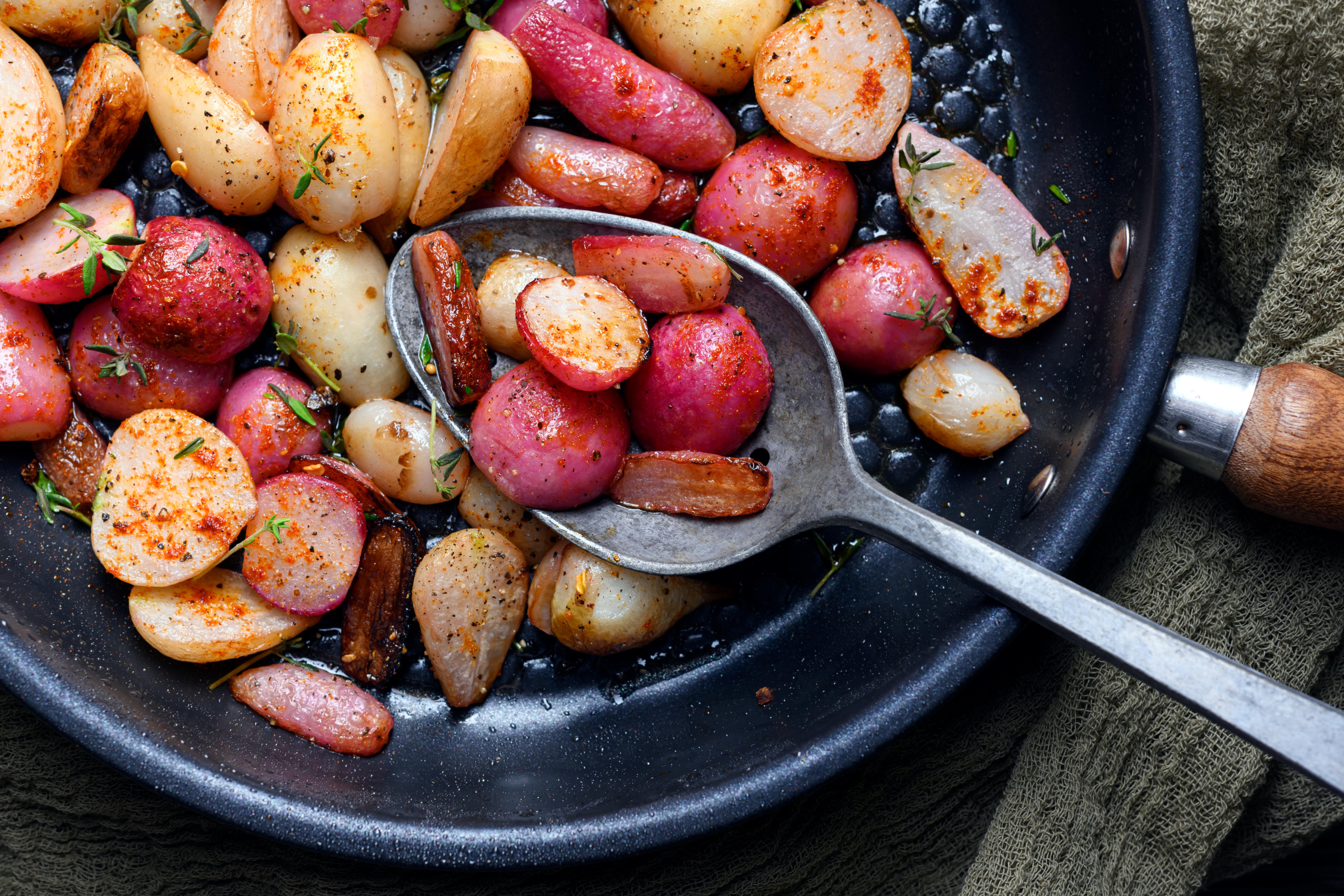"Cycle Syncing" Strategies: Aligning Your Diet & Exercise with Your Hormonal
Understanding your menstrual cycle isn’t just about tracking periods—it’s about tuning into the hormonal shifts that influence energy, mood, metabolism, and even cognition. Cycle syncing is a strategy that adapts your food and fitness routines to these natural rhythms. Instead of pushing against your body, you start working with it. Here are 12 practical, phase-specific strategies—three for each phase—to help you support your hormones and optimize how you feel, function, and perform throughout the month. Let's begin!
1. Menstrual Phase: Nourish with Iron-Rich, Warming Foods

As estrogen and progesterone dip, your body enters a naturally low-energy state. It’s important to replenish iron lost during bleeding and support warmth and comfort. Focus on foods like lentils, leafy greens, bone broth, beets, and dark chocolate. Avoid overly cold or raw meals that tax digestion. Think warming stews, soups, and herbal teas. This is not the time for restriction—your body is already in depletion mode. Honor that by eating slowly and intentionally. Cravings for grounding foods during this time are your body’s cue for restoration, not indulgence.
2. Menstrual Phase: Prioritize Restorative Movement

Your body is in a shedding and rebuilding process—internally and energetically. Instead of pushing through fatigue, opt for restorative practices: slow yoga, walking, or simply stretching. Skip high-impact workouts. This is a time to be gentle, not to chase personal records. Think of movement as circulation support, not performance. Deep breathing, light mobility work, or even staying horizontal is valid. If you reframe this phase as recovery, your next phases become easier to navigate—and your performance improves in the long run.
3. Menstrual Phase: Listen Before Planning

This is your body’s reset button. Use it. Take 10 minutes each day to journal or reflect, not to solve problems, but to listen. What feels right to start? What needs to be let go? The clarity you gain here is hormonal, not just emotional. Low estrogen reduces outside noise, which makes this a natural time for internal decision-making. Don’t rush to act—this phase isn’t about execution. It’s about insight. Let your next cycle be guided by what emerges now. Your hormones are quiet, but your intuition is loud.
4. Follicular Phase: Reintroduce Raw and Fresh Foods

As estrogen begins to rise, so does energy, metabolism, and your body’s ability to digest lighter, raw foods. Reintroduce colorful salads, citrus fruits, sprouted grains, and fermented foods. This is the best time to experiment with new recipes or higher fiber meals—your body is primed for nutrient absorption and gut support. Keep hydration up and consider adding seeds like flax or pumpkin, which support estrogen metabolism. Your cravings will likely shift from comfort foods to fresher options naturally—lean into it without guilt or overthinking.
5. Follicular Phase: Go for Dynamic, Uplifting Workouts

You’re no longer in a low gear. Energy and confidence rise with estrogen, so this is the time to try cardio, dance workouts, running, or power yoga. Anything that feels creative or high-tempo works well here. You can increase your training intensity gradually. Your body is primed for adaptation, which means faster recovery and better performance. Mentally too, motivation spikes—so setting new fitness goals or joining a group class may feel more energizing than overwhelming. Think upward motion—physically and psychologically.
6. Follicular Phase: Make Bold, Brain-First Food Choices

Estrogen doesn’t just lift your mood—it sharpens your brain. This is a powerful time to support cognitive health through foods that are rich in omega-3s, choline, and antioxidants. Think walnuts, eggs, salmon, and dark leafy greens. You’ll likely feel more articulate and socially engaged, so use food to sustain that brainpower. B vitamins and magnesium also help regulate estrogen and keep energy stable. If you have mentally demanding work ahead, this is your fuel-up phase.
7. Ovulatory Phase: Eat to Support Detox & Liver Health

Estrogen peaks during ovulation, which makes liver support crucial. Focus on cruciferous vegetables like broccoli, cabbage, and arugula, and increase your water intake. Your digestion is strong now, so it’s a great time to lean on fiber, bitter greens, and sulfur-rich foods like garlic and onions. These help the body metabolize hormones efficiently and reduce the risk of estrogen dominance. It’s not about “cleansing”—it’s about supporting your natural detox systems during the most hormonally active phase.
8. Ovulatory Phase: Use Your Peak for Power Training

This is your physiological and emotional peak. Your energy is highest, your pain threshold increases, and coordination improves. Leverage that by scheduling your most intense workouts—HIIT, strength training, or any competitive sport. You’re more likely to hit new personal bests during this window. Mentally, you’re outgoing and motivated, so team-based or challenging workouts will feel rewarding rather than draining. But remember: just because you can go hard doesn’t mean you have to. Choose power over pressure.
9. Ovulatory Phase: Focus on Connection-Oriented Eating

With energy and mood peaking, this is a great time to share meals and build connection through food. Whether it’s a home-cooked dinner with friends or a creative lunch out, the social chemistry of this phase amplifies the emotional satisfaction of shared nourishment. From an emotional regulation standpoint, oxytocin and dopamine both get a boost when you feel seen and fed in safe company. Eat well, laugh freely, and allow joy to be a nutrient too.
10. Luteal Phase: Shift to Complex Carbs & Stable Energy

After ovulation, progesterone rises and serotonin starts to dip. Your body becomes more insulin-resistant, so support blood sugar with complex carbohydrates like oats, sweet potatoes, and legumes. Cravings may increase—but that’s often your body seeking stability, not indulgence. Add magnesium-rich foods like dark chocolate, nuts, and seeds to ease PMS symptoms. Avoid skipping meals—your metabolism is up, and under-fueling can worsen mood swings. Eating warm, grounding meals consistently is your best regulation strategy here.
11. Luteal Phase: Downshift Workouts, Not Movement

Your body is preparing to either menstruate or sustain a pregnancy. It’s using more energy at rest, and pushing through fatigue often backfires. Swap intense workouts for resistance training, Pilates, or long walks. This doesn’t mean giving up movement—just recalibrating your expectations. Moderate, consistent exercise improves progesterone balance and supports mood. The goal here is regulation, not intensity. It’s the difference between burning out and staying in rhythm.
12. Luteal Phase: Regulate with Ritual, Not Restriction

This phase often gets dismissed as “the moody one,” but it’s where real emotional intelligence is built. Rituals—tea before bed, wind-down walks, morning journaling—help anchor you as your hormones fluctuate. Avoid crash diets or over-correcting your cravings. Instead, give yourself structure: warm meals at regular intervals, limited screen time at night, and small joys that don’t rely on productivity. This phase teaches you to regulate rather than react—and when you learn to stay steady here, everything else feels easier.
Your body isn’t working against you—it’s asking to be understood. Cycle syncing isn’t about perfection or rigid rules; it’s about learning to listen, respond, and adjust. Each phase offers a different kind of wisdom—whether it’s rest, drive, connection, or recalibration. By aligning your food and fitness with your hormonal rhythms, you’re not just improving your health—you’re deepening your self-awareness. Small shifts create real harmony. And over time, this becomes less of a strategy and more of a relationship—with your body, your mind, and the strength they carry together.